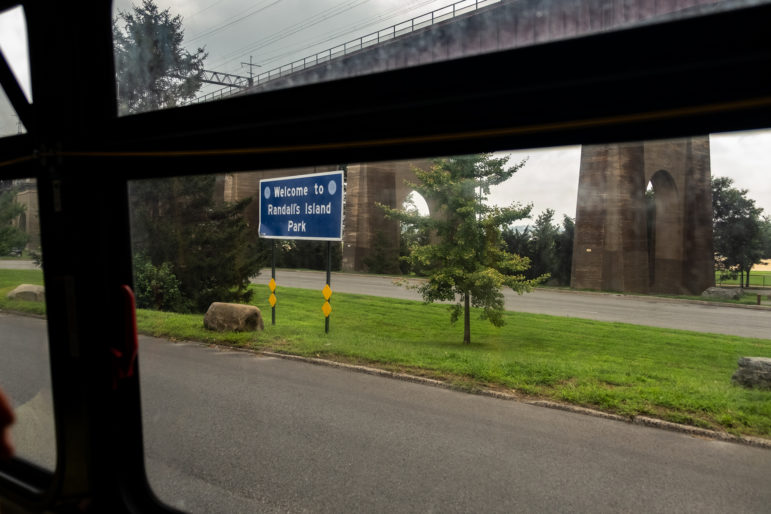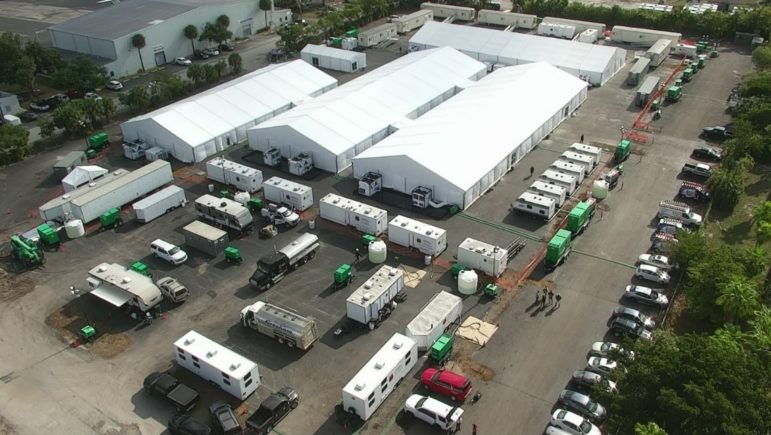
Adi Talwar
A view from MTA’s M35 at it arrives on Randall’s and Wards Island. The bus route is the only one that goes to the island in the East and Harlem Rivers, spurring criticism from some who say it’s the wrong location to send newly arriving immigrants.In the years before Ellis Island opened as the city’s primary point of entry in 1892, many immigrants arriving in New York could expect to stop at Wards Island before heading off into their new country. The island featured a hospital and a barracks for immigrants struggling to find work or earn enough for housing.
More than 130 years later, the same land mass at the confluence of the East and Harlem Rivers will again host newly arriving immigrants, this time as part of the city’s strategy to provide temporary beds to a number of asylum-seekers making their way to New York City after first crossing the Southern Border.
Mayor Eric Adams announced Monday that the city would move a series of refugee camp-style tents from an Orchard Beach parking lot to Randall’s Island—connected to Wards Island since the 1960s—in response to concerns over flooding and isolation.
Adams’ new plan also halves the camp’s capacity, from 1,000 beds to 500.
“This new location is less prone to flooding, is closer to public transportation, and will provide temporary respite to 500 asylum seekers,” Adams said in a statement Monday, adding that the timeline for opening remains the same. City officials have said the camp could open as early as this week.
The abrupt change of venues came two days after the group South Bronx Mutual Aid tweeted a video showing the Orchard Beach site covered in a half-inch of water following a day of rain. Opponents of the plan had previously highlighted the area’s risk for flooding with City and State first reporting on the site’s local nickname: Lake Orchard.

NYC Mayor’s Office
A past example of what the outside of a Humanitarian Emergency Response and Relief Center will look like. New York City’s setups will likely have some differences, according to the mayor’s office.
Adams said officials in the city’s Office of Emergency Management still thought they could mitigate any potential flooding, but determined that “relocating the Orchard Beach humanitarian relief center to Randall’s Island is the most efficient and effective path forward.” The tents will now be located in the parking lot of Icahn Stadium, a top track and field venue.
New York City has so far provided services to 16,000 asylum-seekers in recent months, he added, many of whom have entered the Department of Homeless Services’s (DHS) shelter system. Some were bused to New York City in a political stunt by Republican governors, while many others received aid from nonprofit and church groups. The number of people in DHS shelters has surpassed 60,000 and continues to rise after dropping to about 46,500 at the beginning of the year, according to data tracked daily by City Limits.
Last month, the mayor’s office shared two photos of large tents lined with cots to illustrate the sort of accomodations newly arriving immigrants might receive. That arrangement faced criticism for potentially violating the rules associated with New York City’s unique right to shelter mandate, which ensures every person who requests a temporary bed can get one.
Adams contended that stays in the camp would be voluntary and only for single adults. DHS officials later told City Limits that people could choose to enter their agency’s shelter system instead of the tents. The Legal Aid Society and the Coalition for the Homeless, two court-appointed monitors of the DHS shelter system and right to shelter provisions, have not challenged the camp plan, though members of the City Council’s immigration committee assailed the proposal at a hearing Friday, especially after Politico revealed that the contractor tapped to build the tents previously worked on President Trump’s border wall.
“We should be doing everything we can to provide asylum seekers decent conditions that meet bare minimum standards,” said Councilmember Shahana Hanif, the immigration committee chair. “The right to shelter is a right that applies to everyone in New York City.”
On Monday night, State Sen. Jessica Ramos criticized the plan to erect the tents at Randall’s Island because the island is served by a single bus line—the M35. She also recommended an alternative: leasing out space in empty office buildings.
“On Randall’s Island they’ll be completely isolated and away from communities that can help them,” Ramos said. “This continues to be unacceptable. So much vacant commercial office space. Repurpose it for asylum seekers and our houseless families.”
The tent plan marks just one part of the Adams administration’s approach to adding new shelter beds.
The increase in the shelter population, at the same time that the number of people moving out of shelter to permanent homes has declined, has spurred the city to lease 38 hotels to house homeless families and individuals, consider renting out vacant summer camps and negotiate with cruise ship companies for spare boats. DHS on Friday also opened a new intake shelter at a hotel near Penn Station, first reported by City Limits, with temporary space for nearly 300 households.
The choice of Randall’s Island for the asylum-seeker tents recalls the historic role of the island—along with adjoining Wards Island—as a drop-off point for New York City’s most marginalized groups.
Randall’s Island has been used as a quarantine site for people with smallpox, a series of asylums for people with mental illness and substance use disorder and a jail with brutal conditions for so-called juvenile delinquents—usually poor Irish children living in overcrowded tenements. Wards Island has a similar history. In addition to serving as one of New York City’s pre-Ellis Island immigration stations, the island has hosted a graveyard for New Yorkers who could not afford a cemetery burial, another mental health treatment center still in operation and a collection of homeless shelters served by a lone bus route.
Today, Randall’s and Wards Islands are also home to vibrant parks filled with soccer fields as well as Icahn Stadium.
But like Orchard Beach, the area comes with a risk of flooding. Maps produced by the Federal Emergency Management Administration (FEMA) show swaths of the two islands located within the city’s floodplain.
“Does anyone else remember that year at Governor’s Ball on Randall’s Island when a mere rainstorm completely flooded the island for days and destroyed the grounds?” State Sen. Julia Salazar said on Twitter Monday night following the mayor’s announcement. “Anyway, this sounds like a disaster. Please abandon the refugee camp idea and place people in real housing instead.”









2 thoughts on “Amid Flood Concerns, Mayor Says NYC Will Move Asylum Seeker Tents to Randall’s Island”
Randall and Ward’s Island are connected by 3 bridges with safe walkable footpaths and 2 pedestrian bridges to Harlem, South Bronx, Astoria, and the Upper East Side. But such walks, nice in the summer, are unacceptable during the bad-weather season which has already started. More than 1200 homeless people, Manhattan Psychiatric Center patients and visitors, and users of parks and sports fields already make the one M35 bus line far too crowded. Will Mayor Adams provide enough buses?
Why are we not addressing the homeless problems beforehand, it’s not fair to bypass a problem to fix the damage that is ongoing. O